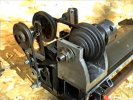
|
The drive train. You have to get power from your motor to your chuck, and you need to do it
so there is little or no slippage. I decided to use springs to keep a constant tension on
the belts.
|
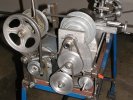
|
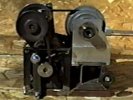
|
This isn't a very clear shot, but was intended to show the first belt from the motor to the
secondary shaft. Note the idler wheel just above the motor pulley. This is mounted to a long
arm which swings around the motor pulley. Tension from a spring pushes the belt further around
the motor pulley and helps give it more traction. Note that the large pulley on the secondary
shaft is too small. This is about a 4" pulley, and I need a 6" to get the proper step-down in
speed.
|
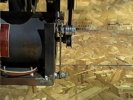
|
This is a close-up of the idler wheel. It was made with a pair of regular ball-bearings I picked up
at the hardware store. These are slide onto a bolt facing each other, so the outer lip of the bearings
creates a track that the belt can ride in. I used washers for spacing, and bolted the assembly directly
to the swing-arm.
|
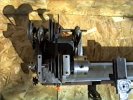
|
Here's a top view of the second belt and step-pulleys. The framework holding the secondary shaft
bushings is 1" angle-iron with a bolt on the bottom of each side allowing for the frame to swing.
There is a piece of 1/2" solid square welded to the angle-iron, just above the motor. This keeps
both sides aligned. There is a spring attached to the left bracket and running down and to the back
of the framework. This keeps a constant pressure on the belt.
|
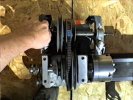
|
When the secondary shaft framework is pulled forward, the belt can easily be moved between steps.
As you may have noticed, my step pulleys are not equal in size, so moving the belt between
settings causes a small difference in how far back the secondary shaft sits when tight. This
alone was the reason for spring-loading the framework originally, but it's so convenient to use
this way that I see no reason to use Gingery's original locking setup. Once I get a wooden
pull-handle bolted to the frame, it will be just as easy to change the belt position.
|
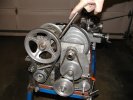
|
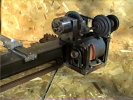
|
One more view from the back side.
|





